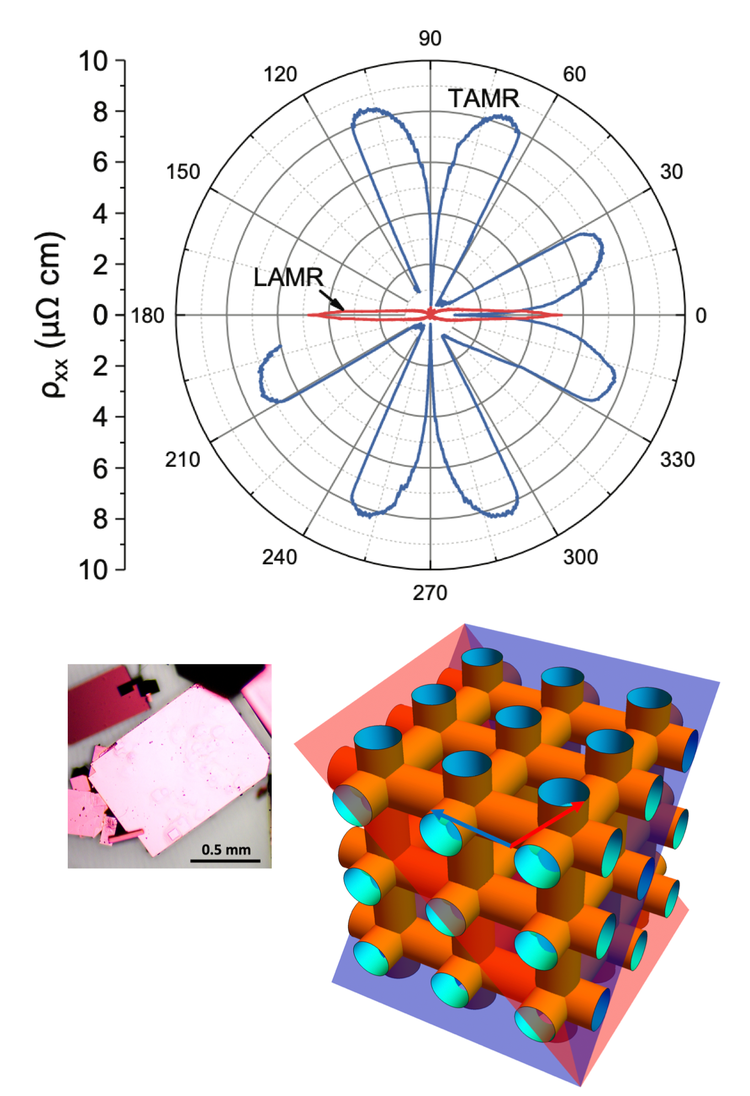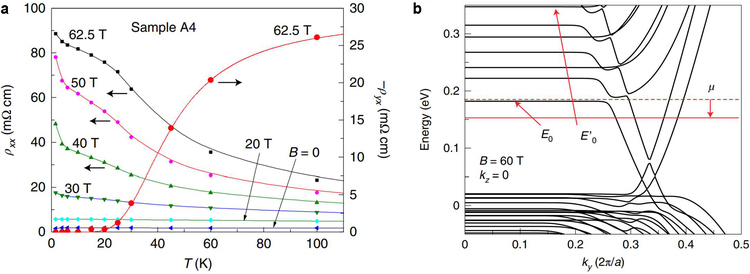Over the years we have conducted many fruitful experiments on bulk crystals grown by collaborators at Princeton (Cava and Schoop, Dept. of Chemistry) and from all over the world. Here are some recent highlights on electronic transport studies in bulk crystals:
- N. Quirk, et al. Singular angular magnetoresistance and sharp resonant features in a high-mobility metal with open orbits, ReO3. Physical Review Materials 5, 105004 (2021).
- In this study we found that the magnetoresistance in the highly conductive transition-metal oxide ReO3 has an extreme singular dependence on the angle of the applied magnetic field. When the field is tilted out of the a-b plane, the magnetoresistance at 9 T changes by more than 100,000%. It increases if tilted in the transverse plane, but decreases if tilted in the plane parallel with the current. We found that this effect is caused by the very high carrier mobility and atypical Fermi surface, which is comprised of a grid of cylinders intersecting at right angles.

- S. Liang, et al. A gap-protected zero-Hall effect state in the quantum limit of the non-symmorphic metal KHgSb. Nature Materials 18, 443–447 (2019).
- A recurring theme in topological matter is the protection of unusual electronic states by symmetry, for example, protection of the surface states in Z2 topological insulators by time-reversal symmetry. KHgSb is predicted to exhibit double quantum spin Hall states, protected by non-symmorphic (glide) symmetry. In strong magnetic fields B up to 62.5 T, we found that KHgSb enters a state with large magnetoresistance but zero Hall resistivity (in a normal metal this would increase linearly with B). We proposed that, in this quantum limit, the chemical potential drops into the bulk gap, intersecting equal numbers of right- and left-moving quantum spin Hall surface modes to produce the zero-Hall state.

- S. Liang, et al. Experimental Tests of the Chiral Anomaly Magnetoresistance in the Dirac-Weyl Semimetals Na3Bi and GdPtBi. Physical Review X 8, 031002 (2018).
- In the 3D Dirac-Weyl semimetal, the chiral anomaly appears as an “axial” current arising from charge pumping between the lowest (chiral) Landau levels of the Weyl nodes, when an electric field is applied parallel to a magnetic field B. Evidence for the chiral anomaly was obtained from the longitudinal magnetoresistance (LMR) in Na3Bi and GdPtBi. However, current-jetting effects (focusing of the current density J) raised general concerns about LMR experiments. Here, we implemented a litmus test that allows the intrinsic LMR in Na3Bi and GdPtBi to be sharply distinguished from pure current-jetting effects. These results considerably strengthen the evidence for the intrinsic nature of the chiral-anomaly-induced LMR.

- T. Liang, et al. Anomalous Hall effect in ZrTe5. Nature Physics 14, 451–455 (2018).
- The anomalous Hall effect (AHE) normally only occurs in ferromagnetic metals where the magnetic ions contribute an additional magnetization-dependent term to the Hall resistance at zero field. In this paper, we found a large AHE signal in a topological (Dirac) semimetal that is completely non-magnetic. Through a series of precise double-axis rotation experiments, we mapped out how the Berry curvature of the Dirac nodes generates this unconventional AHE.

- And many more. Find them here.
